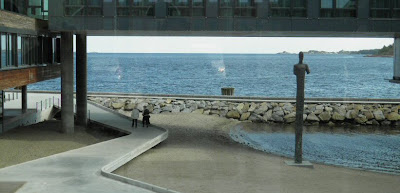
As one of the parallel presentations, my talk “Researching children’s embodied ways of learning” focused on children’s competences that are integrated in their embodiment – competences to sense, experience, wonder, explore and discover what objects (in this case 3D-materials and people) mean to them. The presented study was qualitative and the results were presenting through descriptions and absence of tables and numeric correlations.
I must admit that I was nervous during the preparation for the conference: I knew that my research results did not fit into the current discourse where verbal language learning is privileged, and I had a feeling that qualitative approach was not so welcomed. However, during the conference I learned that many different forms of separating quantitative and qualitative research were represented among the 70 politicians and researchers present at the conference; Some assumed that difference between quantitative and qualitative approach were defined by the methods used (for example, that interviewing is always about qualitative research) and others seemed to assume that the main difference is in the presentation of the results.
 My own understanding, influenced by Robert Stake and Liora Bresler, is that what separates quantitative and qualitative inquiry is how we view the truth. This is an epistemological question foundational for how we see the world: If I believe that many different answers to the same questionare possible, in addition to my own answers – which certainly derives from my own advocacies and subjectivities - I would be curious about possible answers given by others; I would be aware of that my and their answers would be like pieces of puzzle that can complement one another; I would be aware that I do not know everything and that I am in some sense also wrong. On the other side, if I believe that there is only one right answer, and I own it, I might come in position to use this knowledge to gain power, to predict causal relations and to deny the complexity and contextuality of the “produced knowledge”; I might also overlook the certainty (not possibility!) that I am, in some ways, also wrong.
My own understanding, influenced by Robert Stake and Liora Bresler, is that what separates quantitative and qualitative inquiry is how we view the truth. This is an epistemological question foundational for how we see the world: If I believe that many different answers to the same questionare possible, in addition to my own answers – which certainly derives from my own advocacies and subjectivities - I would be curious about possible answers given by others; I would be aware of that my and their answers would be like pieces of puzzle that can complement one another; I would be aware that I do not know everything and that I am in some sense also wrong. On the other side, if I believe that there is only one right answer, and I own it, I might come in position to use this knowledge to gain power, to predict causal relations and to deny the complexity and contextuality of the “produced knowledge”; I might also overlook the certainty (not possibility!) that I am, in some ways, also wrong.Listening to the presentations of causal explanations and economic efficiency in production of human’s academic skills (from birth to age 40) felt like a heavy stone in my stomach. What about ECEC quality the way the children’s themselves experience it? I do not think that three-year-olds care about how much they are going to earn by the age of 35 – but rather care about meaningfulness of their experiences, joyful play (which certainly includes learning), about being respected, belonging, being able to contribute…
However, if young children’s voices would ever be able to influence policy making, it is desperately needed that we, who wish to promote their experiences, make an effort to speak the type of languages that policymakes can understand ... though I fear that this will demand some kinds of compromising our integrity as qualitative researchers.





